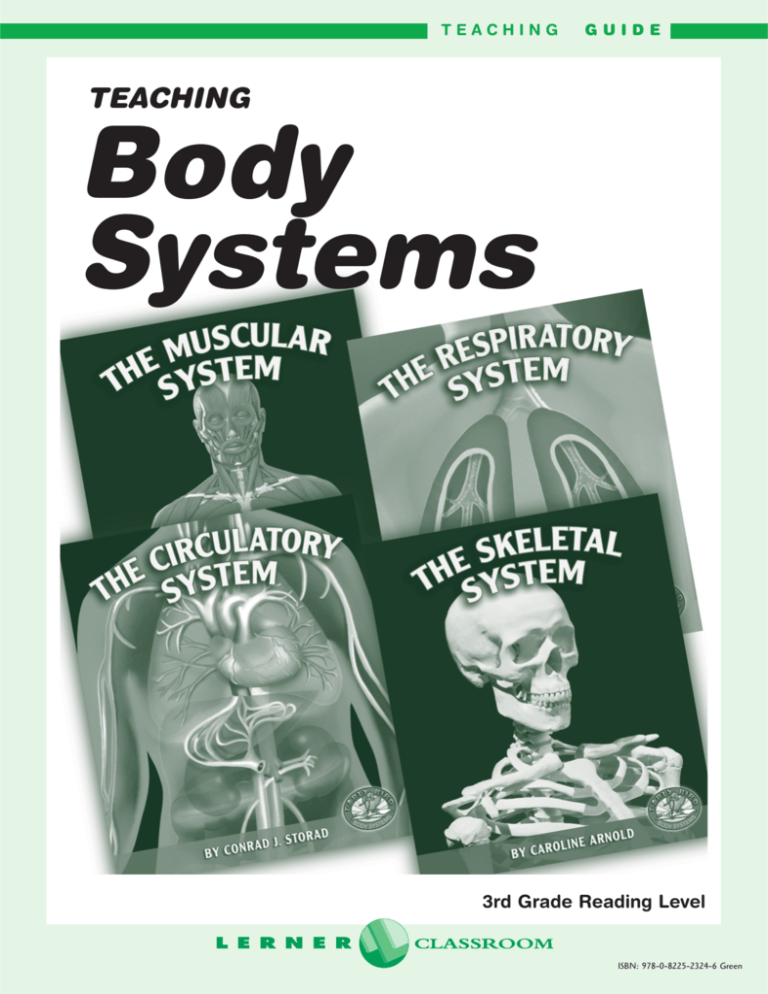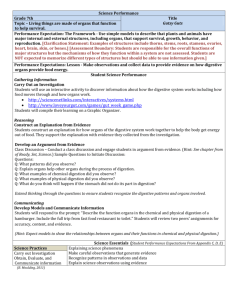
TEACHING
GUIDE
TEACHING
Body
Systems
3rd Grade Reading Level
ISBN: 978-0-8225-2324-6 Green
TEACHING
2
BODY
SYSTEMS
Standards
Health
• Knows how to maintain and promote personal health.
Language Arts— • Demonstrates competence in the stylistic and rhetorical aspects of writing.
Writing
• Uses grammatical and mechanical conventions in written compositions.
• Gathers and uses information for research purposes.
Language Arts— • Demonstrates competence in the general skills and strategies of the reading process.
Reading
• Demonstrates competence in the general skills and strategies for reading a variety of
informational texts.
Science
• Understands the structure and function of cells and organisms.
• Understands the nature of scientific knowledge.
• Understands the nature of scientific inquiry.
Visual Arts
• Understands the characteristics and merits of one’s own artwork and the artwork of
others.
Multiple Intelligences Utilized
• Spatial, linguistic, logical-mathematical, interpersonal, and intrapersonal
Copyright © 2005 by Lerner Publishing Group, Inc.
All rights reserved. International copyright secured. Student pages may be
reproduced by the classroom teacher for classroom use only, not for commercial
resale. No other part of this teaching guide may be reproduced, stored in a
retrieval system, or transmitted in any form or by any means—electronic,
mechanical, photocopying, recording, or otherwise—without the prior written
permission of Lerner Publishing Group, Inc., except for the inclusion of brief
quotations in an acknowledged review.
LernerClassroom
A division of Lerner Publishing Group, Inc.
241 First Avenue North
Minneapolis, MN 55401 U.S.A.
800-328-4929
Website address: www.lernerclassroom.com
Manufactured in the United States of America
2 3 4 5 6 7 — IG — 12 11 10 09 08 07
Books in the Body Systems
series include:
The Circulatory System
The Digestive System
The Muscular System
The Nervous System
The Respiratory System
The Skeletal System
TEACHING
Lesson 1
What’s the Word?
Purpose: Students will recognize and define
vocabulary words relating to the different body
systems.
Materials
• Body Systems books
• Word Cards pp. 9-10
• Reading Skills
Checklist p. 11
• pencils
• scissors
Objectives
• Recall information.
• Restate facts in one’s own words.
• Apply prior knowledge while reading.
• Practice using a glossary.
• Identify bold-faced words in a text.
• Explain the meaning of a word.
Activity Procedures
Prepare
(teacher)
• Copy Word Cards pp. 9–10 back-to-back for each
student.
• Copy one Reading Skills Checklist p. 11 for the class.
Pretest
(teacher, students)
• Students will choose one of the selected Body
Systems books to read.
• Students preview the text independently.
• What do you think you will learn from the book?
Model
(teacher)
• Turn to p. 46 in a Body Systems book.
• Remind students that this is the book’s glossary.
• Demonstrate how to find bold-faced words from the
text in the glossary.
BODY
SYSTEMS
Read
(students)
• Read one book from the Body Systems series.
Practice
(students)
• Each student will complete one Word Card pp. 9–10
for each bold-faced word in the text.
• Students will copy each bold-faced word from the
text onto a word card. They will use the glossary to
write each word’s definition on the back of the card.
• After students have completed the Word Cards
pp. 9–10, they will work in pairs, using the cards as
flash cards to quiz one another on important
vocabulary words.
Discuss
(teacher, students)
• What did you learn?
• Were there any words you already knew? Which
ones?
Evaluate
(teacher)
• Use Reading Skills Checklist p. 11 to evaluate each
student’s reading proficiency.
• Orally quiz students on vocabulary words using their
completed Word Cards pp. 9–10.
3
4
TEACHING
BODY
SYSTEMS
Lesson 2
Name That System
Purpose: Students will demonstrate knowledge of
human body systems by matching system names with
clues describing their component parts and functions.
Materials
• Body Systems books
• pencils
• Name That System
p. 12
• lined paper
Objectives
• Name human body systems.
• Distinguish between different human body systems.
• Demonstrate knowledge of human body systems.
• Identify parts and functions of different body systems.
• Summarize how human body systems work.
• Compare and contrast human body systems.
Activity Procedures
Prepare
(teacher)
• Divide students into small groups to read different
Body Systems books.
• Copy Name That System p. 12 for each student.
Pretest
(teacher, students)
• What are human body systems?
• What are some of the different body systems?
Read
(students)
• Students will read the Body Systems books in small
groups over several class periods. The groups will
rotate books until each group has read all the books
in the series.
• Students may take notes while reading to help them
remember key features of each body system.
Model
(teacher)
• Explain the directions for completing Name That
System p. 12.
Practice
(students)
• Students will complete Name That System p. 12
independently.
• Students may use Body Systems books for reference
only after trying to answer each question on their
own first.
Discuss
(teacher, class)
• Discuss Name That System p. 12 as a class.
• How many systems could you identify without
looking at the Body Systems books?
Evaluate
(teacher)
• Check each student’s Name That System p. 12 for
accuracy.
TEACHING
Lesson 3
Body System Diagram
Purpose: Students will make a life-size replica of one
of the body systems and explain the function of the
system and its organs.
Materials
• Body Systems books
• butcher paper
• black markers
• colored markers or
crayons
• pencils
• note cards
• Body Diagram Rubric
p. 13
• A System at Work
p. 15
• tape
Objectives
• Label the organs and features of a human body
system.
• Explain how a body system works.
• Construct a life-size diagram of a body system.
• Identify the parts of a body system.
• Organize body parts on a diagram according to their
proper placement.
• Verify the correctness of a labeled diagram.
Activity Procedures
Prepare
(teacher)
• Gather seven pieces of butcher paper large enough
to trace a student’s body.
• Divide students into six small groups.
Pretest
(students)
• What are the different body systems?
• What organs make up each system?
• What is each body system’s function?
BODY
SYSTEMS
Read
(small groups)
• Each small group will read a different Body Systems
book.
Model
(teacher)
• Show students the body system diagram on p. 4 of any
Body Systems book. Explain that students will be
creating and labeling their own body system diagrams.
• Demonstrate how to trace a student’s body onto a
piece of butcher paper.
• Show students how to draw and label a life-size body
system diagram.
Practice
(small groups)
• Each group will create their own body system
diagram, using p. 4 of the Body Systems book they
read as a guide.
• Students will color their diagrams and label the
organs using note cards.
• Each group will present their completed body system
diagram to the class, describing the function of each
organ in that body system and how that system’s
organs work together.
Discuss
(class)
• Which group explained its body system best? Why?
• Do any of the systems work together? How?
• How did creating the diagrams help you understand
the body systems?
Evaluate
(teacher)
• Assess the completeness and accuracy of each group’s
diagram and presentation using Body Diagram Rubric
p. 13.
Extension Activity
(students)
• Using A System at Work p. 15, write an essay
explaining how the organs in the system you studied
work together. Explain the importance of the system
5
6
TEACHING
BODY
SYSTEMS
Lesson 4
Compare the System
Purpose: Students will compare and contrast several
body systems.
Materials
• Body Systems books
• Venn Diagram p. 14
• pencils
Objectives
• Identify body systems.
• Distinguish between two body systems.
• Discover similarities and differences between two
body systems.
• Compare the similarities and differences between
body systems.
• Complete a diagram showing similarities and
differences between two body systems.
• Conclude how two body systems are alike and
different using a Venn diagram.
Activity Procedures
Prepare
(teacher)
• Copy Venn Diagram p. 14 for each student.
• Divide students into pairs.
Pretest
(teacher, students)
• How can two things be alike and different at the
same time?
• Explain, giving examples.
Model
(teacher, students)
• Complete a sample Venn Diagram as a class,
comparing two classroom objects.
Read
(students)
• Student pairs will read two different Body Systems
books.
Practice
(students)
• Using the Body Systems books, each student will
complete Venn Diagram p. 14, comparing the two
systems.
Discuss
(pairs, class)
• Students will share their Venn Diagrams p. 14 with
their partners.
• Discuss how two body systems are alike and different.
Evaluate
(teacher)
• Teacher will assess Venn Diagrams p. 14 for accuracy.
TEACHING
Lesson 5
Digestion Beginnings
Purpose: Students will do an experiment to learn
how teeth and saliva aid digestion.
Materials
• The Digestive System
• Digestion Experiment
p. 16
• ten clear glasses
• ten sugar cubes
• pitcher of water
• five mortars and
pestles or five bowls
and spoons
• pencils
• clock (optional)
Objectives
• Predict the outcome of an experiment.
• Observe how two forms of the same substance react
in water.
• Explain why two forms of the same substance react
differently in water.
• Relate how an experiment compares to the digestion
process.
• Describe what happened during an experiment.
• Apply knowledge gained from an experiment to real
life.
Activity Procedures
Prepare
(teacher)
• Collect experiment materials.
• Copy Digestion Experiment p. 16 for each student.
• Divide students into five small groups for the
experiment.
Pretest
(students)
• What do you know about the digestive system?
• How does digestion begin?
BODY
SYSTEMS
Read
(class)
• Read The Digestive System.
Model
(teacher)
• Tell students that they will do an experiment to learn
how the digestive process begins.
• Explain to students that they are going to pour water
over two sugar cubes. One cube will be whole and
the other will be crushed. Students will observe what
happens to each sugar cube.
• Demonstrate how to grind one sugar cube using the
mortar and pestle or the bowl and spoon.
• Ask students to predict what will happen to each
cube, and have them write their predictions on
Digestion Experiment p. 16.
Practice
(small groups)
• Students will perform the sugar and water experiment
and complete Digestion Experiment p. 16.
• You may ask students to record the time it takes for
them to see changes in each of the sugar cubes.
(optional)
Discuss
(class)
• What happened to the two sugar cubes?
• Why did one dissolve faster than the other?
• How does this experiment show what happens when
we chew our food?
• How does this test explain why babies eat baby food
or liquids instead of solid foods?
Evaluate
(teacher)
• Assess Digestion Experiment p. 16 for completeness
and understanding.
7
8
TEACHING
BODY
SYSTEMS
Additional Resources
BOOKS
Avraham, Regina. The Circulatory System.
Philadelphia, PA: Chelsea House Publishers,
2000.
This book describes the circulatory system, its
organs, and their functions.
Ballard, Carol. Digestive System. Crystal Lake, IL:
Heinemann Library, 2002.
This book describes the structure and function of
the digestive system.
Gray, Susan Heinrichs. Muscular System. Plymouth,
MN: A Child’s World, 2003.
Anecdotes and a glossary help explain the
muscular system.
Parker, Steve. Eyewitness: Skeleton. New York: DK
Publishing, 2000.
The structure and function of the human skeletal
system are described in this book.
Parker, Steve. Human Body. New York: DK
Publishing, 2000.
This book examines the different human body
systems.
Royston, Angela. Why Do Bones Break? And Other
Questions about Bones and Muscles. Crystal
Lake, IL: Heinemann Library, 2002.
This book answers questions about bones and
muscles.
Royston, Angela. Why Do Bruises Change Color? And
Other Questions about Blood. Crystal Lake, IL:
Heinemann Library, 2002.
The circulatory system is the subject of this book.
Royston, Angela. Why Do I Get a Toothache? And
Other Questions about Nerves. Crystal Lake, IL:
Heinemann Library, 2002.
Students can find answers to questions about the
nervous system in this book.
Royston, Angela. Why Do I Sneeze? And Other
Questions about Breathing. Crystal Lake, IL:
Heinemann Library, 2002.
This book answers questions about breathing and
the respiratory system.
Royston, Angela. Why Do I Vomit? And Other
Questions about Digestion. Crystal Lake, IL:
Heinemann Library, 2002.
The digestive system is covered in this book.
Showers, Paul. A Drop of Blood. New York:
HarperCollins Publishers, 2004.
This book is a basic introduction to blood—what
it’s made of and how it works.
Showers, Paul. What Happens to a Hamburger. New
York: HarperCollins Publishers, 2001.
Learn how food becomes energy, and how it
builds strong bones and solid muscles as it passes
through the digestive system.
Simon, Seymour. Bones: Our Skeletal System. New
York: HarperCollins Publishers, 2000.
This book describes the function of our bones
and skeletal system.
Simon, Seymour. Brain: Our Nervous System. New
York: William Morrow & Co., 1997.
The brain and nervous system are explained in
this book. Learn how they help us think, feel,
move, and remember.
Simon, Seymour. The Heart. New York: William
Morrow & Co., 1999.
This book describes the heart and circulatory
system, explaining how each part functions.
Simon, Seymour. Muscles: Our Muscular System. New
York: HarperCollins Publishers, 2000.
This book describes different kinds of muscles and
how they work.
WEBSITES
BrainPop
http://www.brainpop.com/health/cellsandbodybasics/
humanbody/
This site contains short animated movies about
the different parts of the body.
Gander Academy Systems of the Human Body
http://www.cdli.ca/CITE/generalhb.htm
This site contains links to kid-friendly sites about
the human body.
My Body
http://www.kidshealth.org/kid/body/mybody_SW
.html
This site shows kids how different body systems
work together.
9
Word Cards
Body Systems Vocabulary Word
Body Systems Vocabulary Word
_________________________
_________________________
Body Systems Vocabulary Word
Body Systems Vocabulary Word
_________________________
_________________________
Body Systems Vocabulary Word
Body Systems Vocabulary Word
_________________________
_________________________
Teaching Body Systems
10
Word Cards
_______________________________
_______________________________
_______________________________
_______________________________
_______________________________
_______________________________
_______________________________
_______________________________
_______________________________
_______________________________
_______________________________
_______________________________
_______________________________
_______________________________
_______________________________
_______________________________
_______________________________
_______________________________
_______________________________
_______________________________
_______________________________
_______________________________
_______________________________
_______________________________
_______________________________
_______________________________
_______________________________
_______________________________
_______________________________
_______________________________
Teaching Body Systems
➤
Name
Teaching Body Systems
pre
v
iew
sp
i
iew cture
s
s
use
s p capti
ide rior k ons
no
nti
w
f
glo ies m led
g
ssa
r y ain id e
u
ind
ea
ex se
u
se
co
mp
r
ski ehen
mm
ds
wr
itte
no ing
nd
te
tak
ire
cti
i
res
on
ear ng
s
ch
Skill ➤
pre
v
11
Reading Skills Checklist
Mastered
A
Developing
B
C
Needs Improvement
D
F
12
Name That System
Name ___________________________________ Date _____________________________
Directions: Match each body system with the clues provided. Write the letter of the system
in the blank next to each clue.
A.
B.
C.
D.
E.
F.
Circulatory System
Digestive System
Muscular System
Nervous System
Respiratory System
Skeletal System
1. This system includes the brain, which receives signals that tell the body what to do, think,
or feel. ____
2. The heart is part of this system that pumps blood to all parts of the body. ____
3. This body system turns food into usable energy and waste. ____
4. This system is known as the framework of your body. ____
5. Tendons connect muscles to bones in this system that helps you move. ____
6. Your lungs are part of this system, which carries oxygen to all of your organs. ____
7. White blood cells work in this system to help protect your body from things that might
make it sick. ____
8. The rib cage is part of this system that protects your internal organs. ____
Teaching Body Systems
13
Body Diagram Rubric
Group Members _____________________________________________________________
Body System ________________________________________________________________
Assess each group’s body system diagram and presentation on the following criteria:
(Assign a point value for each of the following items.)
Points possible for each task _____
Teamwork Skills
___ Each team member took part in the drawing and labeling of the diagram.
___ Team members worked together cooperatively.
Project Skills
___ Diagram was carefully drawn.
___ All relevant organs were included in the diagram.
___ All organs were labeled correctly.
Presentation Skills
___ All group members participated in presentation.
___ Students used appropriate speaking voice.
___ Group members accurately explained the body system they studied.
Total points possible _____
Teaching Body Systems
Total points received _____
Teaching Body Systems
Different
Body System
Same
Venn Diagram
Body System
Name
Different
14
15
Name _________________________________________________________
A System at Work
Teaching Body Systems
16
Digestion Experiment
Name ______________________________________________________________
Directions: As you perform the digestion experiment, answer the questions below.
Before the experiment
1. Hypothesis: What do you think will happen to the two sugar cubes when
water is poured over them?
The whole cube will ______________________________________________
The crushed cube will _____________________________________________
During the experiment
2. Observation: What happened to the two sugar cubes when water was
poured over them?
The whole cube__________________________________________________
The crushed cube ________________________________________________
After the experiment
3. Theory: Why did the two sugar cubes react differently? __________________
________________________________________________________________
________________________________________________________________
________________________________________________________________
________________________________________________________________
4. Application: How does the experiment explain how your body’s digestive
system works? ___________________________________________________
________________________________________________________________
________________________________________________________________
________________________________________________________________
________________________________________________________________
Teaching Body Systems







